Main menu
Common skin conditions

NEWS
Join DermNet PRO
Read more
Quick links
Excessive hair — extra information
Excessive hair
Author: A/Prof Amanda Oakley, Dermatologist, Hamilton, New Zealand, February 2016.
Introduction Introduction - hirsuitism Introduction - hypertrichosis Demographics for hirsutism Demographics for hypertrichosis Causes Causes of hypertrichosis Clinical features Complications Diagnosis Treatment Prevention Outlook
Introduction
Excessive hair comprises two entities:
What is hirsutism?
Hirsutism is a male pattern of secondary or post-pubertal hair growth occurring in women. It arises in the moustache and beard areas at puberty when hair also appears in non-hirsute women in the underarm and pubic regions. Hirsute women may also develop thicker, longer hair than is usual on their limbs and trunk.
Hirsutism is also known as hirsutes.
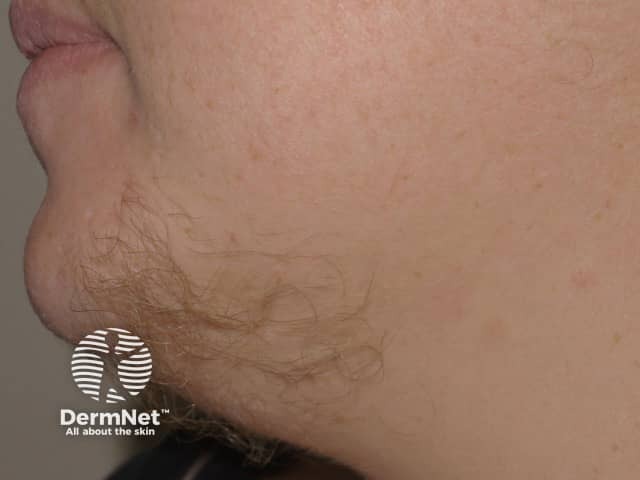
Facial hirsutism
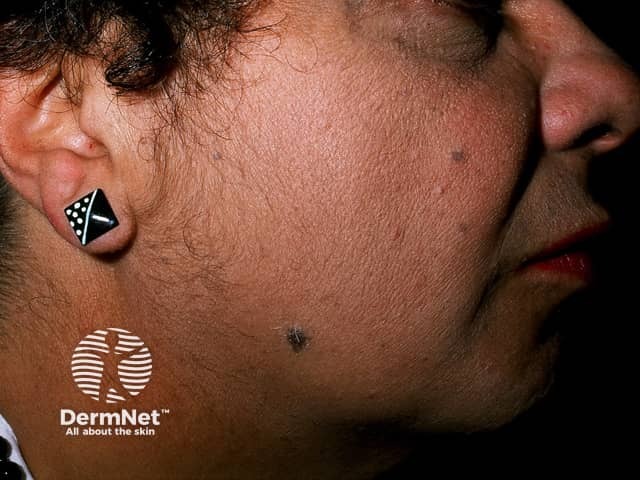
Facial hirsutism
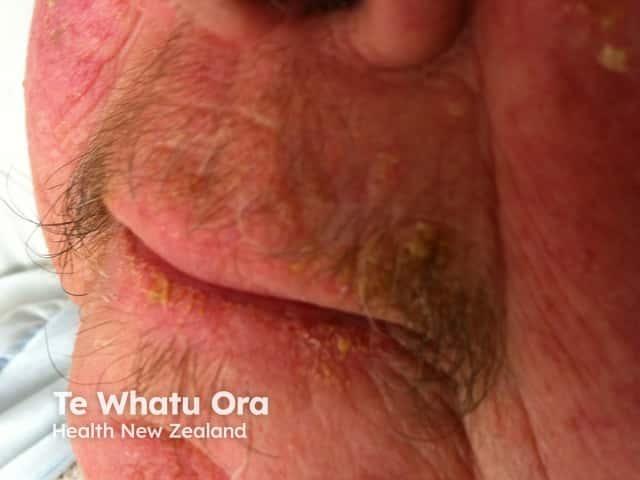
Facial hirsutism
What is hypertrichosis?
Hypertrichosis is non-hirsute excessive hair growth over and above the normal for the age, sex and race of a male or female. It can refer to unpigmented vellus hair or darker, longer, terminal hair, and can be generalised or localised.
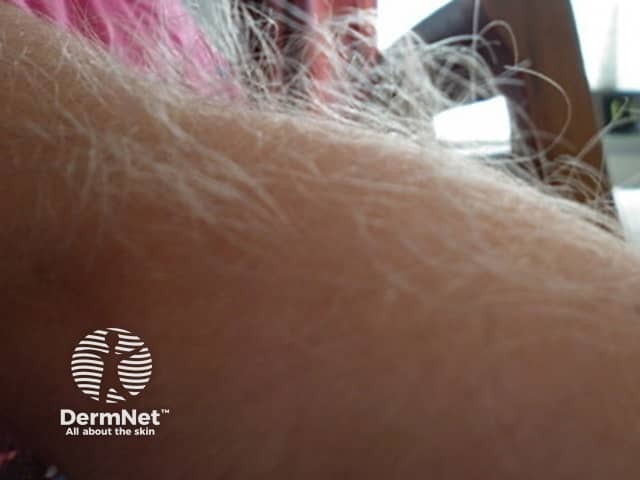
Hypertrichosis
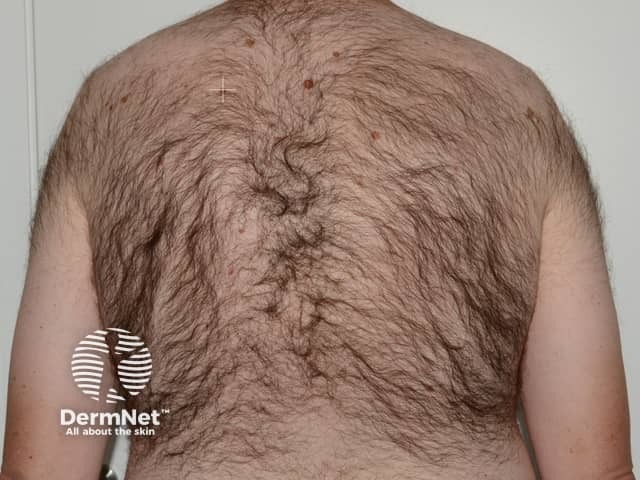
Hypertrichosis
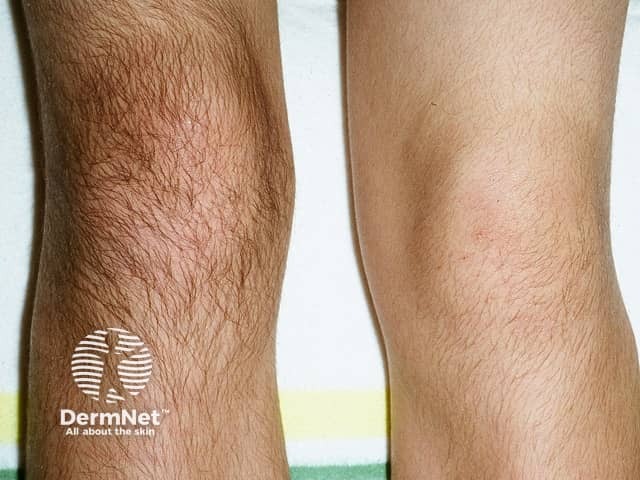
Hypertrichosis
Who gets hirsutism?
Which women are considered hirsute varies according to culture and ethnicity, as the normal range of secondary hair growth varies with race. It should also be noted that women spend a great deal of time and energy removing unwanted hair, resulting in an unnaturally hair-free norm in today’s society.
- A hirsute pattern of hair growth is usually genetically determined, confirmed if male and female family members also have more hair than average.
- Late-onset hirsutism may be due to hyperandrogenism, where there is an increase in circulating androgens including testosterone.
Hyperandrogenism is often associated with polycystic ovaries, insulin resistance and obesity. Rare causes include:
- Androgenic medications
- Cushing syndrome
- Congenital adrenal hyperplasia
- A tumour of the adrenal gland or ovary.
Who gets hypertrichosis?
Hair growth is genetically determined and highly variable. Hypertrichosis may be a subjective complaint of healthy individuals. Pathological hypertrichosis can be congenital or acquired.
Congenital hypertrichosis
- Congenital hypertrichosis lanuginosa, also known as hypertrichosis universalis, and congenital hypertrichosis terminalis are very rare syndromes with autosomal dominant inheritance.
- Naevoid hypertrichosis is a circumscribed area of terminal hair growth. A faun-tail on the lower back may be associated with underlying spina bifida.
- Localised hypertrichosis may also be a feature of congenital melanocytic naevus, vascular malformation, Becker naevus and less frequently, other birthmarks.
Acquired hypertrichosis
Generalised acquired hypertrichosis may be associated with:
- Porphyria cutanea tarda
- Malnutrition, for example, anorexia nervosa
- Malignancy
- A systemic medication such as ciclosporin, phenytoin, androgenic steroids, or minoxidil.
Localised acquired hypertrichosis may be associated with:
- Increased vascularity
- Repetitive rubbing or scratching (lichen simplex)
- The application of a plaster cast (temporary)
- Repeated application of topical minoxidil, a potent topical steroid, iodine, or psoralens (topical PUVA)
- Trichomegaly (long eyelashes) can arise from local bimatoprost or systemic erlotinib.
What causes hirsutism?
Different genes expressed in individual hair follicles vary in their response to androgens.
- Hair follicles in the secondary hair growth sites are more sensitive to androgens than those in other areas.
- Androgens alter mesenchyme-epithelial cell interactions, changing the duration of hair growth, dermal papilla size, and dermal papilla cell, keratinocyte and melanocyte activity.
- Small vellus follicles producing tiny, virtually invisible hairs become larger intermediate and terminal follicles making bigger pigmented hairs.
What causes hypertrichosis?
Hypertrichosis is due to non-hormonal alteration in hair growth driven by genes and cytokines. Precise causes in an individual are often unknown.
What are the clinical features of hirsutism and hypertrichosis?
Hirsutism is usually first noted in late teenage years and tends to get more severe as the woman gets older. Hypertrichosis can be present at birth or appear at any time later on. Affected areas vary.
Hirsutism is usually isolated. It can involve a single site or multiple sites.
- Facial hair: moustache, beard, eyebrows
- Abdomen: a diamond shape of pubic hair extending to the umbilicus
- Chest: around nipples or more extensive growth
- Upper back
- Inner thighs
The severity of hirsutism is assessed using a modified version of the Ferriman-Gallwey visual scale for nine areas of the body. The score varies from 0 (no hair) to 4 (extensive hair growth) in each area.
- Total score < 8: normal hair growth
- Total score 8–14: mild hirsutes
- Total score ≥ 15: moderate to severe hirsutes
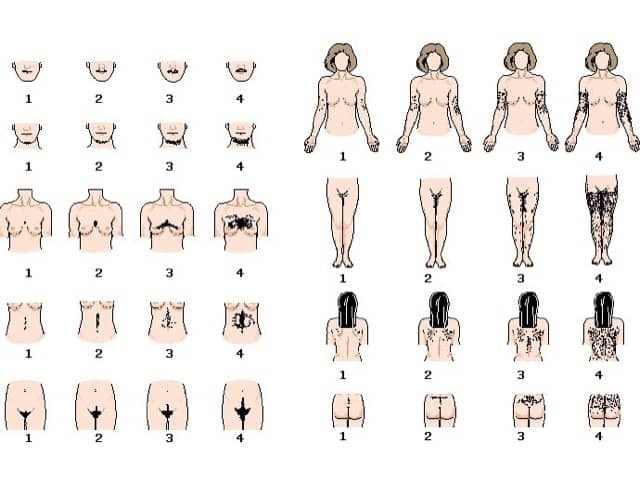
Ferriman-Gallwey visual scale for assessing hirsutism
General examination
A general examination may reveal clues as to the cause of hirsutism.
- Acanthosis nigricans suggests insulin resistance.
- Galactorrhoea suggests hyperprolactinaemia.
- Purple striae, thin skin, bruising and facial plethora suggest Cushing syndrome.
- Virilisation suggests hyperandrogenism. Signs include:
Complications of hirsutism and hypertrichosis
People affected by excessive hair may suffer from great embarrassment with psychosocial effects. They may go to considerable lengths and expense to remove the hair.
Other complications can arise from underlying disease if any.
How are hirsutism and hypertrichosis diagnosed?
Hirsutism and hypertrichosis are diagnosed clinically. Investigations are not usually necessary unless the Ferriman-Gallwey score is > 15 when blood tests are done to evaluate male hormone levels and underlying diseases.
Free androgen index is total testosterone concentration divided by sex hormone binding globulin concentration and multiplied by 100. If elevated, check:
- Dihydroxyepiandrosterone sulfate (elevated if androgen is of adrenal origin)
- Androstenedione (elevated if androgen is of ovarian origin).
If early-onset of hirsutism, premature adrenarche, and family history of congenital adrenal hyperplasia:
- 17-hydroxyprogesterone.
If Cushingoid features:
- Urinary and serum cortisol or overnight dexamethasone test.
If menstrual disorder:
- Luteinising hormone (LH) and follicle stimulating hormone (FSH)
- Prolactin.
If symptoms suggest poor general health:
- Thyroid function
- Glucose
- Lipids (cholesterol and triglyceride)
- Imaging, according to any symptoms.
If suspicious of polycystic ovaries:
- Perform a pelvic examination
- Abdominal/transvaginal ultrasound examination of the ovaries.
Diagnostic features for polycystic ovary syndrome are:
- Oligo/anovulation
- Clinical/biochemical signs of hyperandrogenism
- Presence of ≥ 12 follicles in each ovary, measuring 2–9 mm in diameter and increased ovarian volume (> 10 mL) on pelvic/transvaginal ultrasound (optional).
If there is skin fragility or blisters in sun-exposed sites:
- Check urinary and faecal porphyrins.
If there is a faun tail:
- Image the lower spine.
What is the treatment for hirsutism and hypertrichosis?
Bleaching makes the excessive hair less obvious.
Physical methods of hair removal
Hair removal (epilation and depilation) needs to be regularly repeated as the hair continues to grow back. Methods include:
- Shaving
- Depilatory creams
- Waxing
- Electric hair removers
- Electrolysis and thermolysis
- Lasers and intense pulsed flashlamps.
Hair removal creams containing eflornithine are available on prescription in some countries.
Medical treatment of hirsutism
Some women with hirsutism may be treated with antiandrogens with variable response. This option is not useful in hypertrichosis. Drugs to consider include:
- Oral contraceptives
- Cyproterone
- Spironolactone
- Flutamide
- Finasteride
- Low-dose glucocorticoids
- Metformin
- Rosiglitazone.
How can hirsutism and hypertrichosis be prevented?
It is not yet possible to prevent genetically predetermined excessive hair growth. Insulin resistance associated with obesity can be reduced by weight loss and dietary control.
What is the outlook for hirsutism and hypertrichosis?
Prognosis depends on the cause. The most common types of excessive hair growth persist life-long. Hirsutism tends to be more pronounced with age.
On DermNet
Other websites
